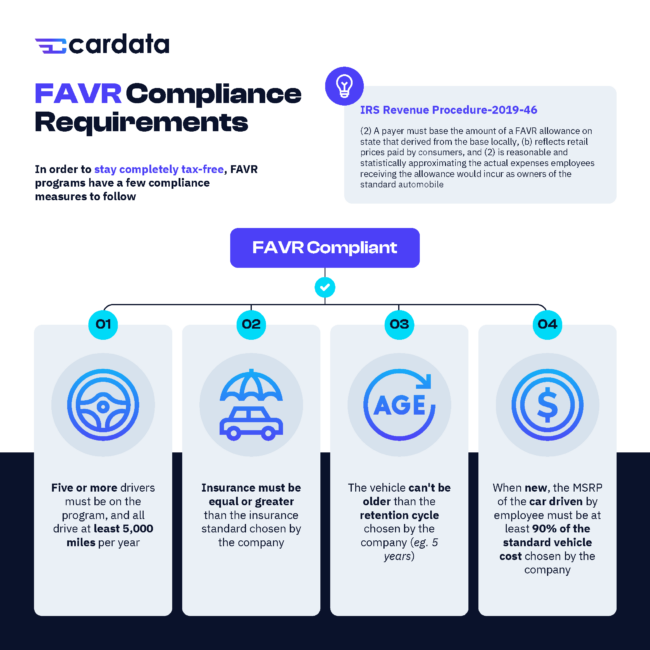Torben Robertson
5 mins
Why companies are choosing FAVR reimbursement programs
Fixed and Variable Rate (FAVR) programs are IRS-compliant vehicle plans that allow employers to provide drivers with tax-free, regional reimbursements.

FAVR stands for “Fixed and Variable Rate.” A FAVR reimbursement program is one that reimburses employees for the use of their personal vehicle at work. FAVR programs, when compliant with IRS regulations, are tax-free. This is their major distinction from allowance programs.
It is also possible to make FAVR programs regionally sensitive; that is, to reimburse drivers based on the driving expenses specific to their region. Insurance and fuel, to take two examples, are priced very differently in different parts of the US. This sets FAVR programs apart from programs that pay the IRS standard rate.
How do I run a FAVR program?
A FAVR reimbursement program can be run in-house, but it is difficult to do so. The reason is that the IRS has strict compliance measures for these programs.
The most difficult thing to do in-house—that is, without an outsourced FAVR provider—is record keeping. For compliance, the IRS requires a mileage log that includes all the following:
- Every trip a driver has done for business purposes
- The reason for the trip
- The starting address
- The ending address
- A starting odometer reading
- An ending odometer reading
- The total mileage driven
Every driver on a FAVR program has to provide that information to their employer. The employer has to store that data in case the IRS wants to see it. When you record this information with a manual mileage log:
- Trips get missed, leaving drivers to pay out of pocket
- Mileage gets erroneously over- and under-reported, which is unfair to both employers and employees
- Administrators waste enormous amounts of time gathering, recording, and filing mileage logs
- Paper mileage logs pile up in the office.
So it is best to outsource a FAVR program to a software company with a mobile mileage capture application and cloud management software. Additionally, when you do not have software, it is difficult to know how
Read more about mileage apps here, and cloud management software here.

What are the compliance measures of a FAVR program?
In order for a driver to be compliant, the following needs to apply to them.
- Their car cannot be more than 7 years old
- They must drive at least 5,000 miles per year
- Car must cost at least 90% of their program standard vehicle profile (which cannot be valued at more than $56,100)
- Drivers must be adequately insured
If your drivers do not meet these requirements, it is best to choose a different vehicle reimbursement program, like the Tax-Free Car Allowance program or Cents per Mile.
WATCH: Mike Levine discusses when Cents per Mile makes sense.
Outsourcing your FAVR program has this added benefit: an external account manager monitors your program and informs drivers and admins of any lapses in compliance.

What are the tax implications of a FAVR program?
Employers and employees both see less tax. Compared to a traditional car allowance, which is fully taxable, a FAVR program can save companies and employees 30%.
When payroll and income tax are both eliminated from an enterprise-level vehicle program, literally millions of dollars can be saved. Those savings can then be redistributed to company projects and into drivers’ pockets.
To reap these tax benefits, your program has to be compliant with all IRS guidelines.
What vehicle expenses do employers pay?
Employers reimburse for 70-75% of the expenses for a vehicle on their FAVR program. The rationale is that a driver is using their car for work roughly 5 out of 7 days of the week: five days is 71.4% of the week.
Employers pay a fixed allowance for fixed expenses like insurance, which are the same no matter how many miles a driver covers. A variable Cents per Mile rate is paid for the variable expenses incurred based on the number of miles driven. The most obvious variable expense is fuel.
What vehicle expenses do employees pay?
Employees pay for roughly 25 and 30% of the vehicle expenses, the assumption being that it is used for personal activities about that percentage of the time.
The amount that employees drive for work influences the amount they are reimbursed, as do the prices of driving-related expenses in their region. One of the great things about FAVR programs is that it is regionally sensitive so that drivers in more expensive places—like dense urban areas—are fairly reimbursed.
Do drivers and administrators save time?
Drivers must keep detailed records if they want tax-free reimbursements, so an in-house FAVR program with manual mileage logging is time-consuming. Mileage apps require far less time, which is why companies choose to outsource their FAVR programs.
The same is true for administrators. In-house programs are time-consuming, but outsourced programs are seamless. However, for administrators who are transitioning off a fleet model, where they supplied company cars for employees, they will immediately notice a reduction in their workload by transitioning to FAVR.
Disclaimer: nothing contained in this blog post is legal or accounting advice. Consult your lawyer or accountant and do not rely on the information contained herein for any business or personal financial or legal decision making.

Share on:


